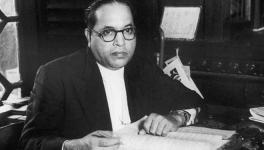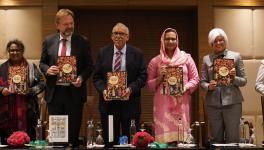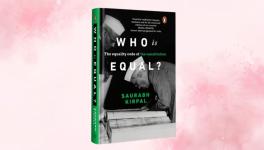Feminist Lawyering: the Other Side of the Independence Movement
FEMINISM is a political approach, perhaps one of the most difficult isms to live by. But then the Constitution of India is itself primarily a political document, in addition to being a legal one. Courts present a space where law can be used as an instrument of social change for women. The Constitution was a direct answer to the demand for equality by women, Dalits, Adivasis and many more subaltern groups.
Over the last fifty years of litigation at the Bombay High Court and the Supreme Court of India, I have believed in the emancipatory nature of the Indian Constitution. From Mary Roy in 1986 to Sabarimala in 2017–2020, I have seen law as a ‘tool for social change’ with the potential to further equality and liberty for women of this country.
My inspiration as a feminist lawyer traces back to the Indian freedom movement and the incorporation of the equality provisions in our Constitution.
For me, the feminist Constitutional journey has been a process of delinking the religious from the secular or the civil.
Besides the struggle for independence from the British rule, there was another struggle going on for centuries and which, to date, still continues. Justice D.Y. Chandrachud, in his Sabarimala judgment for the Supreme Court, called it “the other side of the Independence”. That struggle has been for the social emancipation of woman from oppression. It has been the struggle for the replacement of an unequal social order with a just one. It has been a fight for undoing historical injustices and for replacing fundamental wrongs with fundamental rights. The Constitution of India is the end product of both these struggles. Being a child of Independence, this was my inheritance.
Also read: The pursuit of practical equality for women
Early Indian feminists
A lot of the early struggles for abolishing “immoral” laws began during the British period. Abolition of Sati and the age of marriage laws predate the construction of India. Educated middle class men such as the reformer Raja Ram Mohan Roy (who crusaded against social evils like sati, polygamy and child marriage), the educator Ishwar Chandra Vidyasagar (who championed the cause of widow remarriage) and the social reformer D.D Karve (who worked towards eradicating the bias against widows) took a feminist stand. Scholar and judge Mahadev Govind Ranade founded the Widow Marriage Association in 1861, while Behramji M. Malabari launched a campaign against child marriage and demanded legislature to prevent it.
During this time, Indian women also continued to challenge the status quo in the background, struggling for their place in the sun. Some of the women who went on to become feminist ideals include Dr. Anandibai Joshi – the first Indian woman to study abroad, the poet Kamini Roy – who spearheaded India’s suffragist movement and fought for a woman’s right to education, Dr. Kadambini Ganguly – the first Indian woman to practise medicine in India and one of India’s first two women graduates, Dr. Muthulakshmi Reddy – who studied at a men’s college to become a physician and went on to work towards abolishing the devadasi system, the social reformer Pandita Ramabai – who started a centre to support widows and studied the Kindergarten method of education, Rukhmabai – who defied her child marriage to become one of India’s first practising lady doctors, and the lawyer Cornelia Sorabjee – the first female Indian woman advocate, as well as the first female graduate from Bombay University and the first woman to study law at Oxford University.
There is a failure to understand that religion is not a right but a freedom, that is, the freedom of conscience. We all have the right to believe what we must; what we don’t have is a license to act in a discriminatory manner.
It is in this ‘other side of Independence movement’, where I trace the foundation of my feminist lawyering. Reading the equality provisions along with these multi-facet social movements, a strong foundation of Constitutional equality for women can be developed. India is unique in this respect; no other Constitution in the world before ours attempted this magnitude of social change through Constitutional means. This is a unique feature of our post-colonial Constitution.
While questions have been raised about the lack of effective participation of women in the Constituent Assembly, one cannot discount the feminist potential of the Indian Constitution. It is true that there were only 15 women members (only one of whom was a Dalit woman) in the Constitutional Assembly. Had there been more women, we could have seen a different approach to Constitution making, the law and women’s role in it. However, participation of more women does not automatically lead to equality. Women too have internalized patriarchy, as is evident from the large number of women who opposed the entry of women into the Sabarimala temple, and their voluntary acceptance of secondary roles in relation to their husbands and male family members.
Also read: The colour purple and the issue of gender parity
How my feminism inspired my lawyering
I believe in the transformative role of the courts, which is why I chose to pursue cases that raise important social reformation questions like the rights of hawkers, women’s right to inherit property, the right of the mother as the natural guardian in child custody cases, the unconstitutionality of Triple Talaq, compensation for the victims and survivors of the Bhopal Gas disaster, rights of pavement dwellers, and women vegetable vendors of the Self-Employed Women’s Association [SEWA].
In the Sabarimala case, we undertook an innovative approach to Constitutional interpretation and argued that the exclusionary practice violates Article 17 of the Constitution as denial of entry into temples for menstruating women is a blatant form of “untouchability” based on considerations of pollution and purity. Various religious texts hold the unscientific and irrational belief of women being “ritually unclean” during menstruation, and give the similar treatment to women as accorded to Dalits and untouchables. I argued that the use of the expression “in any form” includes untouchability based on social factors and is wide enough to cover menstrual discrimination against women.
As a woman, the ‘personal’ has fueled my feminist lawyering. I was also inspired by feminist movements against menstrual discrimination in Nepal. Skeptics felt I was appropriating the struggles of the Dalits; however, the Dalits and women were both considered “polluted”, deserving of similar treatment by Manu. At least one Judge accepted this argument and agreed that the impugned practice was a form of untouchability. This is an example of the power of courts to change the agenda for the rights of women and make it emancipatory, which has guided my progress in the profession and in life.
Networking and lobbying play an important role in judicial appointments but women are, by design or by choice, excluded from all male networks.
For me, the feminist Constitutional journey has been a process of delinking the religious from the secular or the civil. Being born into a religion, with its ‘personal law baggage’, the question was how to get out of that religious aspect of life, while at the same time respecting the right to religion.
There was a history to this strategy.
Various social movements (for instance, those by Ram Mohan Roy, anti-caste activist Jyotiba Phule, and activist and politician Periyar, among others) worked towards the abolition of backward social practices associated with religion. They used various arguments to abolish sati and child marriage. Sometimes, it was that these practices were opposed to universal standards of morality and justice, sometimes that the acts complained of were the values of the British realm, and at other times, on the ground that the acts abolished were not “essentially religious”. Sometimes the demand came from the community, in which case the British rulers saw no problems in abolishing the obnoxious practices. The issues always was to maintain the confidence of the local community without interfering with their religious practices. But a strategy which suited the colonial power would not necessarily suit an independent India.
Women continue to be denied equality via religion
Dr B.R. Ambedkar was, therefore, adamant that there must be a separation between religious activities and secular activities wrapped in religious rituals. The latter could have no constitutional immunity under Articles 25 and 26 of the Constitution. Therefore, while guaranteeing the right to individuals to follow the religion of their choice, at the same time our Constitution makes it clear that nothing in these Articles will prevent the State from making any law for social reform or welfare, though “associated with religion”. Social reform here meant that the practice reformed was not “essentially religious”, but secular. A classic example of this could be inheritance rights prescribed by different personal laws, for they deal squarely with the right to property.
And yet, the right to religion is seen as a trump card against any claim of equality by women. Why would a Constitutional court want to maintain discriminatory laws, I asked and found no answers. Unlike politicians, the court, after all, was not looking for votes. Two recent examples of the case-in-point are the Triple Talaq and Sabrimala review cases. In both, the Supreme Court was presented with a historic opportunity to create a jurisprudence of equality rather than fall into the essentialist debate of what is religion and what is not. However, in its judgment, the court failed to separate religion from State, undermining the basic features of the Constitution, secularism and equality.
Also read: Sabarimala Reference: of legal U-turns and infidelity to process of law
There is a failure to understand that religion is not a right but a freedom, that is, the freedom of conscience. We all have the right to believe what we must; what we don’t have is a license to act in a discriminatory manner. A moment which demanded modernization of the institution of marriage was lost.
There is an unfinished agenda for the courts on the issue of equity for woman. Today, the biggest challenge for any feminist lawyer to further equality through the Constitution is the challenge of personal laws. Patriarchy has found its shelter in “personal laws” immunized from being challenge on constitutional grounds in the name of the right to religion. The struggle started with Narasu Appa Mali, a case whose ghost is still haunting the Supreme Court of India. In this case, the Bombay High Court held that ‘personal laws’ are not laws within the meaning of Article 13 of the Constitution of India, and thus beyond judicial scrutiny.
Over the years, the Supreme Court was presented with various obvious opportunities to strike down personal laws which were blatantly discriminatory, but it failed to do. The courts chose to cop out of actually deciding the issue of equality and bringing down a wall of discrimination. Handy tools of ‘reading down’ were used or reliefs were provided to the immediate petitioner without dismantling the codified patriarchy of Indian laws.
Also read: INTERVIEW: Triple Talaq Ruling Fails To Address The Real Suffering Of Muslim Women
Need for gender equality in the profession of legal practice
While the legal cases I fought were an important front for me to translate the feminist demand for equality into legal practice, my battles as a feminist lawyer went beyond court cases. Court corridors, court culture, the Bar and the Bench – all have been sites of struggle for equality.
The legal profession has remained highly male-dominated. Having lived in the twentieth and twenty first centuries, I have seen three generations of families of lawyers, from fathers to sons to grandsons – but never mother to daughter (or father to daughter) to granddaughter as lawyers. Women have found it difficult to enter the profession and make it to both the Bar and the Bench. The representation of woman in the judiciary is abysmally low. It is not my contention that by the virtue of being a woman, you would have a feminist approach, yet I think that representation in and of itself, is an important goal to be achieved by any democratic society. This is a matter of substantive equality.
The major reason for the limited number of women judges is the secretive collegium process. The system lacks transparency and is completely flawed. Networking and lobbying play an important role in appointment but women are, by design or by choice, excluded from all male networks. Unless objective and transparent standards of selection are specifically provided, women would continue to not reach up to the Bench in larger numbers to provide a critical mass.
Feminism has given me the lens through which I interpret the Constitution, and an approach to my advocacy and my life.
Another reason is the rule of seniority; women are often late-comers to the judiciary and hence become eligible for appointment well after the men, who are ahead in the queue. There is no affirmative action in the matter of appointment of judges to the High Court and Supreme Court for women or for other protected groups. Yet another issue that has come to light is sexual harassment of women judges, compelling them to drop out of the judiciary.
Despite all the odds, it has been an exhilarating journey though courts. I love my work primarily because I have been able to stand my ground as a woman and not ape male lawyers or allow myself to be patronized by them. Male judges love patronizing women lawyers; it is part of a familiar game, which can have dangerous consequences for women. I have represented woman judges who have been sexually harassed by their seniors, sometimes successfully and often unsuccessfully. Its then that you realize that actually, a woman’s word is worth half that of a man. Who will bear witness to sexual harassment at the workplace without being sacked or victimized?
Also read: Reimagining a justice and legal system which actively eliminates hierarchies
Feminism has given me the lens through which I interpret the Constitution, and an approach to my advocacy and my life. There has been success on the way, and so-called failures as well. Yet, I don’t consider any case as ‘lost’. Each case leads to the next step in a spiral ladder climbing higher and higher. Every case is a precedent for the next one to be relied upon or undone. The avenue of legislative undoing has also been explored successfully. There are no full stops to judgments; every judgment is a conversation between stakeholders, enriching our contribution to the rule of law.
(The above is based on an article the author wrote titled, ‘Feminist Lawyering’ for a book published by the Indian Bar Association. The views expressed are personal.)
Get the latest reports & analysis with people's perspective on Protests, movements & deep analytical videos, discussions of the current affairs in your Telegram app. Subscribe to NewsClick's Telegram channel & get Real-Time updates on stories, as they get published on our website.
























